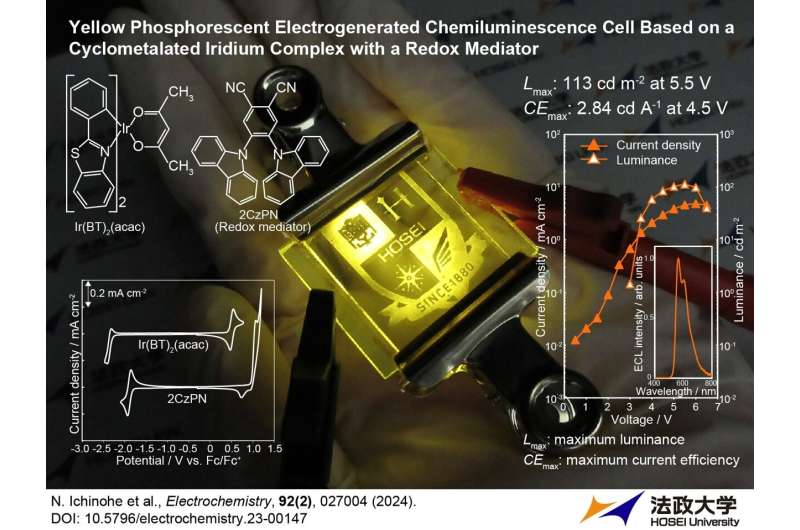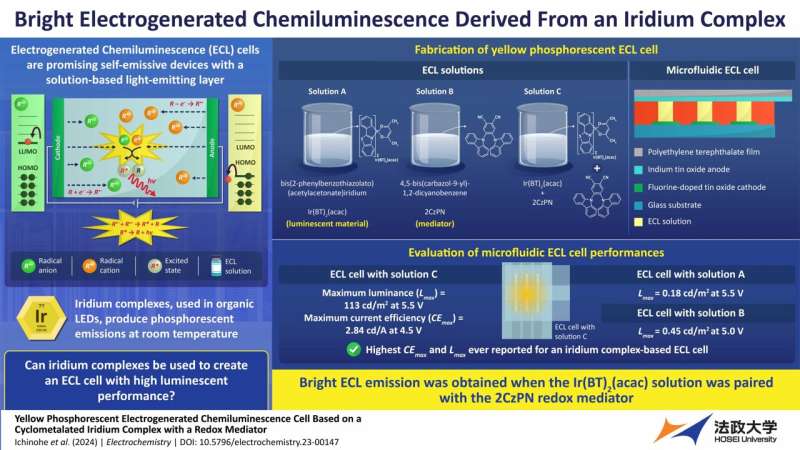This article has been reviewed according to Science X's editorial process and policies. Editors have highlighted the following attributes while ensuring the content's credibility:
fact-checked
proofread
Enhancing electrogenerated chemiluminescence of an iridium complex

Electrogenerated chemiluminescence (ECL) cells, characterized by their self-emissive nature, have gathered significant interest for prospective display applications due to their uncomplicated structure and straightforward fabrication process. These cells are created by sandwiching a solution-based emitting layer between two transparent electrodes. Nevertheless, when compared to other self-emissive devices like light-emitting diodes (LED) and organic LEDs, the luminescent performance of ECL cells remains subpar and is currently undergoing improvement.
In contrast, iridium complexes are widely used in efficient organic LEDs due to their ability to produce room-temperature phosphorescent emissions from their excited states. The emission colors can be easily adjusted by changing ligands, and researchers have explored their properties using both theoretical and experimental methods.
In a recent study led by Associate Professor Takashi Kasahara and Nanami Ichinohe, a master's student at Hosei University, and including collaborators from the University of Fukui and National Cheng Kung University, researchers have successfully designed a highly luminescent ECL cell by utilizing an iridium complex and a mediator. This study has been published in the journal Electrochemistry.
According to Dr. Kasahara, "ECL is a light-emitting phenomenon induced by an electron transfer reaction between the radical anion and cation of the luminescent material. Although conventional ECL solutions have been typically prepared by dissolving specific amounts of a single luminescent material in an organic solvent, in this study, we have prepared a solution that contained two luminescent materials."

The two luminescent materials employed in the study were a yellow phosphorescent iridium complex (Ir(BT)2(acac)) and a sky-blue thermally activated delayed fluorescent (TADF) material, labeled as 2CzPN, serving as a redox mediator. For the experimental setup, three variations of ECL solutions were created and assessed using microfluidic cells developed by the research team. Among these solutions, two exclusively contained the iridium complex and the mediator, while the third incorporated both components.
The microfluidic ECL cell, incorporating both components, showcased a vivid yellow ECL emission arising from an electron transfer reaction between the radical cation of Ir(BT)2(acac) and the radical anion of 2CzPN. It was seen to achieve a peak luminance exceeding 100 cd m−2 and a maximum current efficiency of 2.84 cd A−1.
These values represent the highest values reported for ECL cells based on an iridium complex. Notably, the luminance of this cell exceeded that of the ECL cell without 2CzPN by more than two orders of magnitude. In 2023, the authors also improved the luminescent performances of the yellow fluorescent ECL cell by using the mediator. This led the authors to conclude that the developed ECL system applies not only to fluorescent materials but also to phosphorescent materials.
"We expect that this ECL system using the redox mediator will be actively investigated by many research groups across the world and contribute to future (in probably several decades from now), highly luminescent and efficient solution-based self-emissive display applications," says Dr. Kasahara.
In summary, researchers have successfully engineered a yellow phosphorescent ECL cell incorporating an iridium complex and a redox mediator. This cell exhibits the highest luminance ever reported for iridium complex-based cells and is expected to pave the way for the development of next-generation ECL-based displays.
More information: Nanami ICHINOHE et al, Yellow Phosphorescent Electrogenerated Chemiluminescence Cell Based on a Cyclometalated Iridium Complex with a Redox Mediator, Electrochemistry (2024). DOI: 10.5796/electrochemistry.23-00147
Provided by Hosei University





















